Based in Finland, Nokia transformed from being a diverse conglomerate into a world-leading mobile phone producer in
Question:
Based in Finland, Nokia transformed from being a diverse conglomerate into a world-leading mobile phone producer in the 1990s. Since then, the company has experienced very tough operating conditions in the face of competition from Samsung and products like the Apple iPhone. Substantial layoffs and plant closures took place across the world as Nokia missed out on consumers who were turning to smartphones.
By concentrating on mobile phones, Nokia also faced intense competition from large volume producers in China with lower cost structures.
A new CEO was appointed from Microsoft in 2010 and he quickly sent a memo to all employees.
The memo, rich in metaphor, became known as the ‘burning platform’ memo and basically said that Nokia had missed out on some big consumer trends and was now years behind the market and, while that was happening, top managers in Nokia thought they were doing the right thing and making good decisions.
The new CEO accused Nokia of lacking accountability and leadership, of not collaborating enough internally and not innovating fast enough. He likened the situation that the company faced with being on a burning oil platform, the implication being that Nokia could stay where it is and perish in the flames, or jump into icy waters and have a chance of survival.
Despite the new CEO’s ‘call to arms’, market share, revenues, profits and share price continued to fall.
In 2013, Microsoft purchased Nokia’s mobile phone business and the CEO moved to Microsoft as part of the deal.
If Nokia continues to lose share in the market then the Finnish economy will suffer further. The company had helped put Finland on the map as a technological leader and employer of a lot of people.
Questions
Situations of change such as that outlined at Nokia draw attention to the complexity of the change environment. However, we can do more than simply identify the various triggers for change. Analyzing the relationships between them – their systemic nature – is even more important. The multiple-cause diagram in the case example is an attempt to do this.
Multiple-cause diagrams have the power to capture the complex dynamics of change situations. They help bring about a deeper understanding of how changes in one variable can have far-reaching effects in other parts of the situation. They act, therefore, not only as a descriptive model, but also as an analytical tool for understanding and managing change.
1. Using further information from the Internet, write a brief account of how different elements of the temporal and competitive environments interact to influence the situation at Nokia.
2. Consider how you could use multiple-cause diagrams to ‘picture’ the multiple and interacting causes that bring pressure for change where you work, or in an organization that you know well.
Step by Step Answer:

Organizational Change
ISBN: 9781292243436
6th Edition
Authors: Barbara Senior, Stephen Swailes, Colin Carnall





